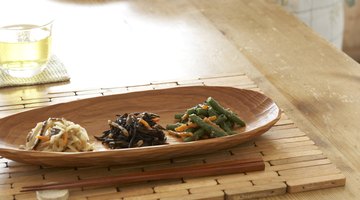How to Reduce Wood Table Swelling
Wood is a porous, natural product that expands and contracts in response to the amount of moisture in the environment. Although some finishes can help minimize this process, all wood furniture has the potential to swell or shrink slightly.

Contact the manufacturer if joints are cracking or becoming loose due to swelling. This problem may be caused by faulty production that the manufacturer should correct.
Tip
Occasionally, a wood table may swell because it was improperly constructed. The wood may not have been dried to a uniform moisture level, or it may be constructed so that wood cannot contract and expand in response to changes in the environment. How the joints are secured can also affect the table's durability. Some wood types, such as maple, oak and beech, are more likely to swell or shrink than other types of wood. Mahogany has one of the lowest rates of shrinkage.
-
Avoid placing hot items on the table, which can cause the wood to swell and crack the finish. Place wood tables out of direct sunlight or over heating vents.
-
Use a humidifier or dehumidifier to maintain a relatively consistent level of humidity in your home. High levels of humidity cause the wood table to swell, while low levels cause the wood to shrink. Alternating cycles of high and low humidity can cause the wood table to crack. An air humidity level between 25 and 35 percent is ideal for wood furniture.
-
Place coasters under drinks, and a tablecloth or trivet under a vase filled with water. Even if water doesn't spill, it can condense, causing the table to absorb moisture and potentially swell.
-
Wipe up any spills immediately with a clean cloth and avoid wetting the table to clean it. Even small amounts of water can cause the table to swell.
-
Expose wet areas of wood that are swollen to heat in order to dry and restore them. Place the furniture in sunlight, or over a heating vent for two to three hours, to thoroughly dry the wood. Move the wood, though, as soon as it is dry because excessive heat or sunlight can warp it.
The Drip Cap
- Wood is a porous, natural product that expands and contracts in response to the amount of moisture in the environment.
- Place coasters under drinks, and a tablecloth or trivet under a vase filled with water.
- Even if water doesn't spill, it can condense, causing the table to absorb moisture and potentially swell.
- Expose wet areas of wood that are swollen to heat in order to dry and restore them.
Writer Bio
Julie Christensen is a food writer, caterer, and mom-chef. She's the creator of MarmaladeMom.org, dedicated to family fun and delicious food, and released a book titled "More Than Pot Roast: Fast, Fresh Slow Cooker Recipes."
Photo Credits
- ULTRA F/Digital Vision/Getty Images
- ULTRA F/Digital Vision/Getty Images
More Articles



